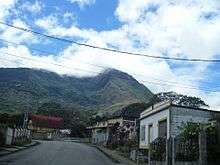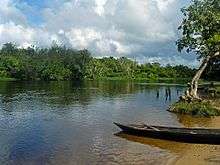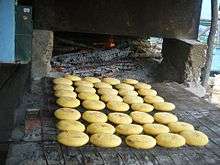Monagas
| Monagas | ||
|---|---|---|
| State of Venezuela | ||
| ||
|
Motto: Resistió con valor (English: It resisted with courage) | ||
| Anthem: Himno del Estado Monagas | ||
 Location within Venezuela | ||
| Coordinates: 9°26′N 63°05′W / 9.43°N 63.08°WCoordinates: 9°26′N 63°05′W / 9.43°N 63.08°W | ||
| Country | Venezuela | |
| Created | 1909 | |
| Capital | Maturín | |
| Government | ||
| • Governor | Yelitza Santaella (2012–present) | |
| Area | ||
| • Total | 28,900 km2 (11,200 sq mi) | |
| Area rank | 9th | |
| 3.15% of Venezuela | ||
| Population (2011 census) | ||
| • Total | 905,443 | |
| • Rank | 13th | |
| 3.15% of Venezuela | ||
| Time zone | UTC-04:30 | |
| ISO 3166 code | VE-N | |
| Emblematic tree | Palma de Moriche (Mauritia flexuosa) | |
| Website |
www | |
Monagas State (Spanish: Estado Monagas, IPA: [esˈtaðo moˈnaɣas]) is one of the 23 states of Venezuela.
Monagas State covers a total surface area of 28,900 km² and, as of the 2011 census, had a population of 905,443.
Monagas State is surrounded by Sucre State in the north, Anzoátegui State in the west and south, Bolívar State in the south, Delta Amacuro State in the south and east and the Paria Gulf in the northeast.
The state is named after the general and president of Venezuela José Tadeo Monagas, native from this state, and his brother and fellow president José Gregorio Monagas, native from the neighbor Anzoátegui State.
The capital of the state is Maturín.
Municipalities and municipal seats
- Acosta (San Antonio de Capayacuar)
- Aguasay (Aguasay)
- Bolívar (Caripito)
- Caripe (Caripe)
- Cedeño (Caicara de Maturín)
- Ezequiel Zamora (Punta de Mata)
- Libertador (Temblador)
- Maturín (Maturín)
- Piar (Aragua de Maturín)
- Punceres (Quiriquire)
- Santa Bárbara (Santa Bárbara)
- Sotillo (Barrancas del Orinoco)
- Uracoa (Uracoa)
History
Chaimas, Waraos, Arawacos, and Kalina (Caribs) are some of the Indian peoples who had been living in the territory of Monagas state before the colonisation of this land by the Spaniards. The former Indian town of Uyapari (today the town of Barrancas of Orinoco) was the centre of a splendid kind of pottery admired by some European explorers as Diego de Ordaz. Scholars, who studied this pottery, gave the culture which designed it the name of Barrancoide Culture.
After a probable arrival of Columbus to the coast of Monagas State during his third voyage in August 1498 many explorations were done to this land. Some of the most famous Spanish explorers were Diego de Ordaz (discover of the Indian town of Uyapari), Diego de Lepe, Juan Bono de Quejo and Antonio Berrio. Apart from that, some hunters of Indians from the islands of Cubagua and Margarita sail around Monagas state looking for slaves in some Indians towns. The colonization of this state was very slow, for the resistance made by the Caribs. These Indians defended their freedom, families and lands against the Spanish conquerors who wanted to hunt and sell them to the encomenderos (persons who need slave for cultivating their farms).
This situation began to change when Franciscan missioners arrived from Spain in order to evangelize the Indians. The Franciscans are the responsibles of the establishment of many missions which became in towns later. Some of these towns founded by the Franciscans are San Antonio (founded in 1710 by Gerónimo de Muros), Guanaguana (founded in 1729 by Pacián de San Martín), Caicara (founded in 1731 by Ambrosio de Blesa), Caripe (founded in 1734 by Pedro de Gelsa), Santa Bárbara (founded in 1754 by Casimiro de Borja), Maturín (founded in 1760 by Lucas de Zaragoza), Barrancas (founded in 1790 by Joaquín de Morata) and so on.
However these foundations were not so easy. At the beginning some Indians, especially the Caribs, attacked the group of missioners. Some Franciscans died for the attacks, others died for the tropical sicknesses or for the rude conditions they were living. When the Caribs were driven out from the banks of Guarapiche River by the Spanish governor of Cumaná Pedro Carreño, the missioners were able to continue with the foundations of mission stations around Monagas State.
The lands of Monagas were the scene of many battles during the fight for the independence of Venezuela. The most famous battles took place in Maturín.
During the period of the republic, Monagas state had a slow growth because of the frequent civil wars which destroyed possessions and killed cattle and men. Another cause of this problem was the increment of deaths produced by tropical sicknesses as the yellow fever. The landscape change when oil fields were discovered in this land. The new petroleum activity stimulated industrial and commercial activities which attracted persons from other states and countries. Punta de Mata, El Tejero, Temblador are examples of towns which were born around the oil fields. Maturín became in an important commercial and banking centre in the east of Venezuela.
In relation to the political formation of this entity, Monagas was part of the province of Nueva Andalucía, which became in the province of Cumaná, in the 16th, 17th, 18th and the middle part of 19th centuries. In 1856 Monagas was raised to the level of province with the name of province of Maturín. In 1864 was ratified the new Maturín state. But in 1879 these lands lost their autonomy and formed part of the east state.
In 1891 Monagas was added to the great Bermúdez state, which was composed by Sucre, Anzoátegui, Monagas, Bolívar states. Monagas got again the autonomy in 1901 with the name of Maturín state. However Monagas lost this condition in 1904 when it was added to the Bermúdez state.
At the end Monagas was separated from Barcelona state in 1909 and became a state with its current name.
Geography
Relief
The state has many plateaus and savannas located in the southwest. In the northeast and the southeast there are deltaic savannas in which rivers such as San Juan, Guanipa, Caño Mánamo, Río Tigre flow into. In the northwest there is a group of mountains belonged to the eastern mountain range. This mountain range is divided in two massifs: the massif of el Turimiquire (in which the town of San Antonio is located) and the massif of Caripe (in which the town of Caripe is located).
Mountains

Cerro Negro (2000 m.) is the highest mountain of Monagas State.
Weather
The weather is hot in the area of the Llanos, while it is cold in the mountains located in the north of the state. The average temperature in the low areas is between 25 and 28 °C. In the area of the town of Caripe the cold temperature permits the cultivation of certain kind of typical plants from cold weathers as roses and strawberries. The level of rainfalls in the state is between 530 and 1400 mm during the year.
Hydrology

The rivers of the state belong to one of the two basins that are located in the state. The basins are the basin of Atlantic Ocean and the basin of the Orinoco River. Rivers such as Guanipa, Río Tigre, Morichal Largo, Caño Mánamo, Amana, Tonoro, Tabasca, Uracoa flow into the Orinoco River. On the other hand, the rivers Guarapiche, San Juan, Río de Oro, Caripe flow into the Atlantic Ocean. The rivers of the Atlantic Ocean basin come from the mountains located in the northwest of the state and the rivers of the Orinoco river basin come from the many plateaus located in the southwest of Monagas State and from Anzoategui State.
Vegetation
The vegetation is the intertropical one. This vegetation is adapted to the different altitudes, weathers and kinds of soil of the state. Typical trees are el araguaney, la ceiba, el jobo, el aceituno, la vera, la palma de moriche and el mangle.
Protected areas

Cueva del Guácharo National Park, was created on May 1975 by the Venezuelan government to protect the ecosystem surrounding the Guacharo’s Cave. The park has a surface area of 155 km² and covers the mountainous areas of Acosta and Caripe municipalities in Monagas state and Ribero municipality in Sucre state.
Alejandro de Humboldt National Monument can be located inside the park El Guácharo. This national monument was created in 1949 to protect the Guacharo’s Cave. This national monument is named after the German explorer Alexander von Humboldt, who visited the Guacharo’s cave in 1799.
Another protected area is Guarapiche Forestal Reserve, which protects the forests located at the bank of Guarapiche and San Juan Rivers.
Population
The population of Monagas State has increased since the 1920s due to the opening of its oil fields. The majority of its inhabitants are Mestizo|mestizos; that is, they result from the progeny of native Indians, Black Africans and White Europeans. Many people from neighbouring states as Sucre and Nueva Esparta, as well as persons from other countries as Spaniards, Italians, Portuguese, Syrian, Lebanese and Chinese have immigrated to the state because of the petroleum industry and business opportunities. The majority of the population is concentrated in the northern area of Monagas state. At least fifty percent of inhabitants live in the capital state Maturín. Important towns are Punta de Mata, Temblador, Caripito and Caripe.
Race and ethnicity
According to the 2011 Census, the racial composition of the population was:[1]
| Racial composition | Population | % |
|---|---|---|
| Mestizo | N/A | 54.8 |
| White | 359,473 | 38.8 |
| Black | 42,618 | 4.6 |
| Other race | N/A | 1.8 |
Economy

The main economical activity is the exploitation of oil. Many towns as Punta de Mata, El Tejero, Temblador depend on this activity.
Other towns as Caripe and San Antonio live off agriculture and livestock farming. Coffee is planted in the areas next to the towns of Caripe and San Antonio. Cocoa is being cultivated near Caripito. Maize, tomato, sugar-cane, tobacco, banana, rice, yucca and tropical fruits grow in other areas.
Cattle is concentrated in the southern and western parts of Monagas, where there are great extensions of savannas and plateaus.
The state has forests with its corresponding industry.
Because of the oil exploitation Maturín is a main commercial and banking centre in the east of Venezuela.
Education
At university level Monagas state has the following public university institutes:
In Caripe
- Universidad Nacional Abierta (UNA).
In Caripito
- Universidad Nacional Abierta (UNA).
- Instituto Universitario Tecnológico de Caripito.
In Maturín
- Universidad de Oriente, Núcleo Monagas (UDO-Monagas).
- Universidad Bolivariana de Venezuela (UBV).
- Universidad Pedagógica Experimenta Libertador-Instituto Pedagógico de Maturín (UPEL-IPM).
- Universidad Nacional Abierta (UNA).
- Universidad Nacional Experimental Simón Rodríguez (UNESR).
In San Antonio
- Núcleo del Instituto Pedagógico de Maturín (UPEL-IPM).
And these private university institutes:
In Caripe
- Instituto Universitario Pedagógico Monseñor Arias Blanco.
In Maturín
- Universidad Gran Mariscal de Ayacucho (UGMA). Only postgraduate studies.
- Universidad Cecilio Acosta (UNICA). Only postgraduate studies.
- Universidad de Margarita (UNIMAR).
- Universidad Santa María (USM).
- Instituto Politécnico Santiago Mariño (IUPSM).
- Instituto Universitario de Tecnología Industrial Rodolfo Loreto Arismendi (IUTIRLA).
- Instituto Universitario de Tecnología Venezuela (IUTV).
In Punta de Mata
- Instituto Universitario de Tecnología de Cumaná (IUTC).
- Universidad Nacional Abierta (UNA).
Culture
Monagas state has a culture very similar to other eastern states of Venezuela. Natives of Monagas share with the population of the eastern states the quick manner of speaking the Spanish language, the food, some musical rhythms as the galerón or el Joropo, typical clothing as Liquiliqui of Los LLanos and the veneration for the Virgin of El Valle.
Cuisine

Typical dishes of Monagas state are arepa (a kind of bread made of maize), cachapa (an omelette made of maize), casabe, empanada, mondongo (a kind of soup), queso de mano (a kind of cheese), jalea de guayaba (guayaba jelly), carne en vara (meat grilled on a stick). Fish are a very important food for the cuisine of a native of this state. In Christmas is traditional to eat hallacas, pan de jamón (ham bread), torta negra (black cake), ensalada de gallina (hen salad), dulce de lechoza ( papaya sweet). In the holy week cuajado de morrocoy is a typical dish for the belief that is profane to eat meat in these days. Also in the Holy Week is typical Cuajado de cazon in the area of the Eastern coast.
Dances
Typical dances of Monagas state are el Baile del Mono (Monkey’s Dance), holds on each 28 December in the town of Caicara and el Baile de la Culebra (Snake’s Dance), celebrated in the town of Ipure next to San Antonio of Maturín.
Religion
The predominant religion of this state is Christianity. Catholicism is the Christian branch which has the biggest amount of followers. It is the consequence of the evangelization made by catholic missioners, as the Franciscans, in 17th and 18th centuries. The capital, Maturín, is seat of a catholic diocese since 1958.
On the other hand, the blending of catholic rites with the rites of other religions like the Indian and African ones is very extended. For example, it is usual to find people who venerate María Lionza, the Indian chief Guaicaipuro and Felipe the Black.
Some Protestant churches have been established in different towns around the state. Among them are Pentecostals, Lutherans, Baptists, Adventists of the Seven Day, Mormons and Jehovah’s Witnesses. Anglicans has a church in the area of Caripe.
Islam is practiced by some immigrants from Arabic countries, although they do not have a mosque in the state. It is possible to find in Maturín followers of Buddhism, Hinduism, Methaphysics, and other faiths.
Public holidays
Popular public holidays are:
- Carnivals: between February and March.
- Holy Week: between March and April.
- Virgin of El Valle Festival: 8 September.
- Christmas’ Eve: 24 December.
- New Year’s Eve: 31 December.
Apart from that each town celebrates public festivities in honor of its patron saint when his/her day is held.
Regional anniversaries are
- Battle of Los Godos’ Day: 25 May.
- General José Tadeo Monagas’ Birthday: 28 October.
- Maturín’s Foundation Day: 7 December.
Governors
Governors chosen in Popular Election
- Guillermo Call. (1990–92); (1993–95) Acción Democrática
- Luis Eduardo Martínez. (1996–1998); (1999–2000) Acción Democrática
- Miguel Gómez. (2000) Movimiento Quinta República
- Guillermo Call. (2001–2004) Acción Democrática
- José Gregorio Briceño. (2004–2008) MIGATO, Movimiento Quinta República; (2009–2012) United Socialist Party of Venezuela
- Yelitza Santaella. (2012—2017) United Socialist Party of Venezuela.
Notable natives
From Amana of Tamarindo, town of Maturín municipality
- José Tadeo Monagas, general of the Venezuelan independence and president
From Barrancas
- Alarico Gómez, poet, novelist and journalist
From Caicara
- Manuel Núñez Tovar, doctor and entomologist
- Rafael Naranjo Ostty, abogado criminólogo
- Wilfrida Corvo de López, educadora
From Caripe
- Félix Antonio Calderón, poet
From Caripito
- Doris Wells, actress
- Juvenal Ravelo, artist
- Cherry Navarro, singer
- Tibursio C. Aparicio Lozada, poet
- Manny Trillo, professional baseball player
From Chaguaramal, town of Piar municipality
- Juana Ramírez (a.k.a. Juana la Avanzadora) heroine of the Venezuelan independence
- Leonardo Infante, general of the Venezuelan independence
From Guanaguana, town of Piar municipality
- Antonio Ciliberto Pérez, poet and novelist
From Maturín
- Andrés Rojas, general of the Venezuelan independence
- Carlos Möhle, musician, composer and dentist
- José Gabriel Núñez Romberg, musician
- José Antonio Núñez Romberg, mathematician, teacher and historian
- Félix Armando Núñez, poet, teacher und dean of Chile's university
- Idelfonso Núñez Mares, poet and teacher
- Eloy Palacios, sculptor
- José María Núñez, historian
- Benito Raúl Lozada, poet and writer
From Musipán, town of Ezequiel Zamora municipality
- Benjamín Rausseo (a.k.a. Er Conde del Guácharo), television comedian
From San Antonio
- Julián Padrón, writer, journalist and lawyer
- William H. Phelps, Jr., ornithologist and founder of RCTV
- Carlos Salazar Liccioni, poet, novelist
- Julio Gómez Peñalver, dentist, teacher and poet
From Uracoa
- Mateo Manaure, painter, artist
- Jesús Rafael Zambrano, journalist, lawyer, writer
References
- ↑ "Resultado Básico del XIV Censo Nacional de Población y Vivienda 2011 (Mayo 2014)" (PDF). Ine.gov.ve. p. 29. Retrieved 8 September 2015.
Sources
- González Oropeza, Hermann(1985): Historia del Estado Monagas. Ediciones Amon C.A., Caracas. (Biblioteca de Temas y Autores Monaguenses; Colección Guanipa; Ensayos e Investigaciónes)
See also
| Wikimedia Commons has media related to Monagas (state). |
